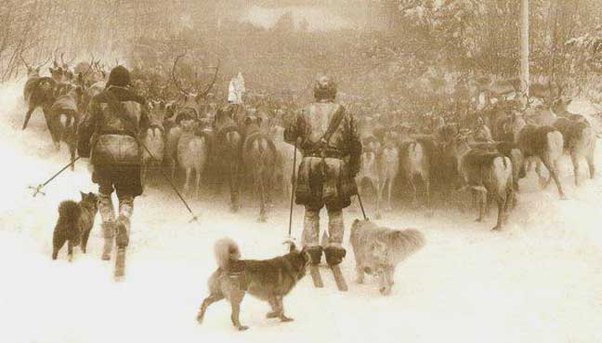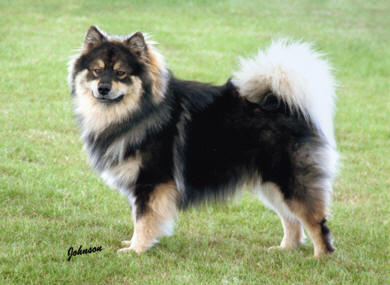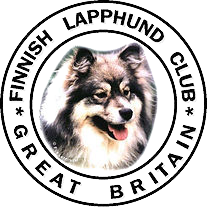Breed History

History over time.
There are few cultures where the lives of man and dog are so tied together as they have been in the harsh conditions of Lapland. Lapphunds have made it possible for Sami people to earn their living by herding reindeer; at the same time the dogs earned food for themselves. The Samis (Laplanders) have an old proverb: “Give the first bite to the dog and it will work harder than you”. When the Laplanders and the dogs found one another no one knows, perhaps it happened from time immemorial. The dogs were trustworthy, independent, fearless and capable of defending themselves whenever needed. Dogs of this kind are still used by the reindeer breeders of today in their work.
The Arctic Spitz of Lapland was, for thousands of years, similar to the types seen today – this has been confirmed by archaeological findings. A survey was carried out during 1959 to 1961 of the dogs found herding the reindeer and two different types were evident. One was a nearly square, longhaired galloper; The Finnish Lapphund, the other was longer than its height, had a shorter coat, was bigger than the Lapphund and moved at a trot; The Lapponian Herder.
In Finland, today’s breeding pays particular attention to the proportions and strength of the skeletal structure of the body and head, together with the arctic suitability of the coat and with its colour – in which a lot of variation is accepted.
Although the 2nd World War destroyed a large part of Lapland and its dogs, a good number were saved and the Finnish Clubs continue to strive to maintain the Finnish Lapphund to the type depicted in the pictures from the old standards and the stories of reindeer herding. The breed standard of the Lapphund was confirmed in 1975 and subsequently revised in 1982 and 1987. The standard has now undergone its final fine tuning to meet FCI requirements and was reissued by the FCI 12/3/99. (Note; the Interim Standard issued by the UK Kennel Club does differ from the FCI Standard on a number of points).
One should never forget that the Lapphund is one of the most perfect products of nature and a part of the Finnish tradition worth taking care of. Heavy work in austere life conditions has made our Lapphunds healthy, modest farm-hands, content with very little and excellent companions for the whole family. They do everything that they can for their master and dinner plate! Therefore the contentedness and the lovely smile of the Lapphund is readiest when they are allowed to act according to the orders and instruction of their master.

In the past our domestic herding dog has been called a Lapp herd dog, Lapp Spitz dog and a Lapp hound but since 1993 the breed has been called the Finnish Lapphund (Suomenlapinkoira) originating from the longhaired dogs used for reindeer herding in Lapland. It is still to some extent used as a shepherd dog for herding reindeer, cattle and sheep but the majority of Lapphunds serve as pet dogs and watch dogs for country houses and more densely populated areas, i.e. yard dogs.
According to the registrations of the Finnish Kennel Club the breed is amongst the top five most favoured breeds in Finland. The popularity of the Lapphund is based on its health, character, conformation and variety of colouring. For a family keen on outdoor life and exercise this dog is an excellent all year round companion for all weathers.
The variety and combination of colours are as much part of the attraction of this breed as are the dazzling good looks which prove immensely popular in Finland not only for showing but also as a family dog. One of the National Dogs of Finland, the Lapphund is of medium size, strongly built and capable of a days work herding reindeer. Characteristics and temperament are accurately summarised in the Breed Standard which states; tendency to herd, intelligent, brave, calm, faithful; suitable as a companion and watch dog.
Only those fortunate to be owners will know just how typical that description is of the breed.
The breed works in Lapland to this day as a herder of reindeer. It is described by the Lapps as a galloping dog and works alongside the Lapponian Herder, a trotting dog. Between them the two breeds are said to work herds ideally – their styles perfectly complimenting each other.
Written information on the Lapphund is scarce, most of the information, we are told, is written in obscure Lapplandic dialects which even the Finns have trouble interpreting. We do know that the breed is still strong in Lapland and the Finns, when they wish to introduce new stock, travel north to select from the working packs.

Introduction into the UK
The UK story starts in 1989 when Sue & Roger Dunger imported the first Finnish Lapphund into the UK. Since her arrival there has been an orderly progression in numbers with further imports and a controlled number of litters being bred.
Those involved with the development of the breed to date have been determined that there should be no immediate explosion in numbers as seen in some other newly imported breeds. This has meant that our breed has had time to settle, for hip scores and eye tests to be carried out and we now know, as far as this is possible in a relatively short time, that the breed is both healthy and sound. The average hip score is encouragingly low with the breed mean score at 14 (range 9 – 35) from 23 dogs scored under the BVA scheme (at the time of reporting); at the time of writing (July 2010) the mean is now 13 (range 6 – 40) from 138 dogs scored. A large proportion of the adult stock in the UK has been eye tested clear but 2 cases of suspected PRA have been reported in older dogs.
In 1991 the top bitch in the breed in Finland, SF MVA Lecibsin Hissukka, was flown to the UK in whelp and her litter of five was born in quarantine, Sue and Roger Dunger were responsible for this population explosion! The puppies were released at 8 weeks of age and Hissukka was flown home to Finland. Subsequent importation included a brown and tan dog; Staalon Runne of Sulyka, a black and tan dog; Tsinghuan Poarka at Chelville, plus a further three bitches (cream, red sable and wolf sable).
A slow and careful breeding programme then started and since the first litter born in quarantine a further 29 litters had been produced up to 1999 – varying in size from 2 to 8 pups per litter. 1999 was yet another exciting year for the introduction of new blood; the Finnish Champion SF MVA Eetla came into quarantine and whelped a litter of 4 in the March. She was to be joined later in the summer at the Chelville kennel by Staalon Kidda, an older puppy bitch brought in under the Balai Directive. In the last 2 years further imports have joined the UK population to further enhance the gene pool. As a result of the carefully planned importations we have a number of distinct breeding lines available in this country – the future looks interesting.
The Finnish Lapphund had originally been granted Import Register Status by the Kennel Club which restricted the breed showing to Matches, Exemption Shows plus Import Register Classes at open and championship show level. The breed was not eligible to compete in breed classes, however since the Irish Kennel Club did not operate an Import Register category the breed was eligible to compete in breed classes, where scheduled, and in AVNSC Pastoral classes and a number of Finnish Lapphunds have crossed the waters and been awarded Green Stars.
The Finnish Lapphund Club of Great Britain was founded by a small band of enthusiasts in May 1994 with the intention of protecting and furthering the interest of the breed in the UK, in November 1995 the Club was provisionally recognised by the Kennel Club.
As a club we have been actively involved in educating interested parties about the breed, participating in The Meet The Imports Day (organized by the Kooikerhunje Club), in the judges seminars organized by the NWPB society and we have held our own seminars. We have also organized a number of fun days & weekends where enthusiasts can meet and talk about the breed, take part in activities with the Lapphunds and meet as examples of the breed as possible at one time.
When the Club was formed the Founder Members set up a Code of Ethics which forms part of the Rules of the Club and since the members are keen to preserve health and type of this ancient breed a number of points are considered important to bring to attention of anyone considering acquiring a Finnish Lapphund.
Prior to mating all stock must be tested under the BVA/KC schemes for hereditary cataracts (HC), progressive retinal atrophy (PRA),persistent hyperplastic primary vitreous (PHPV), persistent papillary membrane (PPH), multifocal retinal dysplasia (MRD) and hip dysplasia (HD) i.e. a current annual eye certificate must be held prior to mating as well as a Hip Dysplasia score. Copies of the results should be made available to the Breed Health Co-ordinator for public listing and reference.
Excerpt from – Jack Chetwynd
FLCGB Chairman (1995 – 2010) Deceased.
Breed Status
April 2002
The Finnish Lapphund was finally granted Rare Breed Status by the Kennel Club on 1st April 2002.
September 2009
On 9 September 2009 the Kennel Club allocated the Finnish Lapphund Championship Status with the first set being awarded at Crufts with the invitation going to Breed Specialist Toni Jackson in 2011.
2024 – Coming Soon
